Lowrance electronic GlobalMap 3300C User Manual
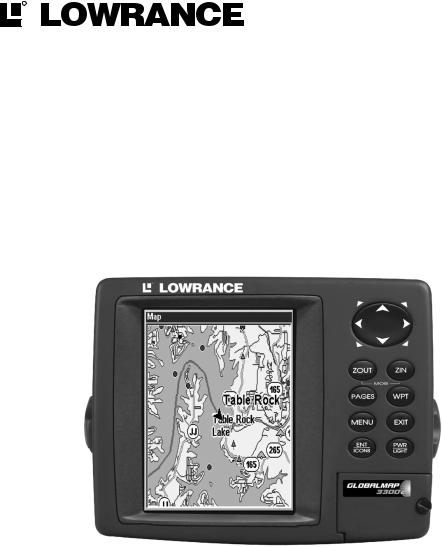
Pub. 988-0156-021
www.lowrance.com
GlobalMap 3300C
Mapping GPS Receiver
Installation and Operation
Instructions
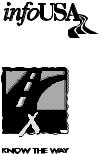
Copyright © 2004 Lowrance Electronics, Inc.
All rights reserved.
Lowrance® is a registered trademark of Lowrance Electronics, Inc. MapCreate is a trademark of Lowrance Electronics, Inc.
Navionics is a registered trademark of Navionics, Inc.
Points of Interest Data in this unit are by infoUSA,  copyright 2001-2004, All Rights Reserved. infoUSA is a trademark of infoUSA, Inc.
copyright 2001-2004, All Rights Reserved. infoUSA is a trademark of infoUSA, Inc.
eXitSource Database, copyright 2001-2004 Zenrin Co. 
 Ltd. Exit Authority and eXitSource are trademarks of
Ltd. Exit Authority and eXitSource are trademarks of 

 Zenrin Co. Ltd.
Zenrin Co. Ltd.
Lowrance Electronics may find it necessary to change or end our policies, regulations and special offers at any time. We reserve the right to do so without notice. All features and specifications subject to change without notice. All screens in this manual are simulated.
For free owner's manuals and other information, visit our web site:
www.lowrance.com
Lowrance Electronics Inc.
12000 E. Skelly Dr.
Tulsa, OK USA 74128-2486
Printed in USA.
Table of Contents |
|
Sec. 1: Read Me First! ............................................................... |
1 |
Capabilities and Specifications: GlobalMap 3300C...................... |
2 |
How Lowrance GPS Works .......................................................... |
4 |
Introduction to GPS and WAAS................................................... |
6 |
Free Training Aids Available ....................................................... |
8 |
Unit Emulator........................................................................... |
8 |
How to Use this Manual: Typographical Conventions................ |
9 |
Sec. 2: Installation & Accessories ........................................ |
11 |
Preparations................................................................................ |
11 |
GPS Antenna/Receiver Module .................................................. |
11 |
GPS Module Installation ........................................................ |
12 |
Connecting Directly to the Unit ............................................. |
14 |
Connecting to a NMEA 2000 Network................................... |
15 |
Power Connections ................................................................. |
16 |
Powering a NMEA 2000 Buss (NMEA 2000 Power Cable)....... |
17 |
Powering your Unit (Power Supply Cable)................................ |
17 |
NMEA 2000 Cable Connections ................................................. |
19 |
NMEA 0183 Cable Connections (Data Cable) ........................... |
20 |
Mounting the Unit: Bracket or In-Dash Installation................ |
21 |
MMC or SD Card Memory Card Installation............................ |
24 |
Face Cover................................................................................... |
25 |
Other Accessories........................................................................ |
25 |
Sec. 3: Basic GPS Operations................................................ |
27 |
Keyboard ..................................................................................... |
27 |
Power/Lights (Turn Unit On and Off) ....................................... |
28 |
Main Menu .................................................................................. |
28 |
Pages ........................................................................................... |
30 |
Satellite Status Page .............................................................. |
30 |
Navigation Page...................................................................... |
32 |
Map Page................................................................................. |
34 |
Background Map vs. Mapcreate Map Content ............... |
36 |
Resize Window Command .................................................. |
38 |
Basic GPS Quick Reference .................................................. |
40 |
Find your Current Position ........................................................ |
41 |
Moving around the Map: Zoom & Cursor Arrow Keys.............. |
41 |
Selecting any Map Item with the Cursor .................................. |
42 |
Searching..................................................................................... |
42 |
Set a Waypoint............................................................................ |
45 |
Create Waypoint at Current Position ................................ |
45 |
Create Waypoint on Map .................................................... |
46 |
Create Waypoint by Entering a Position ........................... |
46 |
Navigate to a Waypoint .............................................................. |
47 |
i |
|
Set Man Overboard (MOB) Waypoint........................................ |
48 |
Navigate Back to MOB Waypoint .............................................. |
48 |
Navigate to Cursor Position on Map.......................................... |
49 |
Navigate to a Point of Interest................................................... |
50 |
Creating and Saving a Trail....................................................... |
50 |
Displaying a Saved Trail ............................................................ |
52 |
Navigating Trails........................................................................ |
53 |
Visual Trailing ........................................................................ |
53 |
Navigate a Trail (Forward)..................................................... |
53 |
Navigate a Back Trail (Backtrack, or Reverse)..................... |
56 |
Transfer Custom Maps and GPS Data Files ............................. |
56 |
Cancel Navigation....................................................................... |
58 |
Sec. 4: Advanced GPS Operations ....................................... |
59 |
Find Distance from Current Position to Another Location ...... |
59 |
Find Distance from Point to Point ............................................. |
59 |
Icons............................................................................................. |
60 |
Create Icon on Map................................................................. |
60 |
Create Icon at Current Position ............................................. |
60 |
Delete an Icon ......................................................................... |
61 |
Navigate to an Icon................................................................. |
61 |
Routes.......................................................................................... |
62 |
Create and Save a Route ........................................................ |
62 |
PC-Created Routes.............................................................. |
62 |
Routes Created in the Unit................................................. |
62 |
Delete a Route......................................................................... |
65 |
Edit a Route Name.................................................................. |
65 |
Edit Route Waypoints............................................................. |
65 |
Navigate a Route..................................................................... |
66 |
Navigate a Route in Reverse .................................................. |
67 |
Trails ........................................................................................... |
68 |
Delete a Trail .......................................................................... |
68 |
Edit a Trail Name ................................................................... |
69 |
Edit a Trail Color .................................................................... |
69 |
Edit a Trail Pattern ................................................................ |
69 |
Utilities........................................................................................ |
70 |
Alarm Clock............................................................................. |
70 |
Sun/Moon Rise & Set Calculator............................................ |
70 |
Trip Calculator........................................................................ |
70 |
Trip Down Timer..................................................................... |
70 |
Trip Up Timer ......................................................................... |
70 |
Waypoints.................................................................................... |
70 |
Delete a Waypoint................................................................... |
70 |
Edit a Waypoint (Name, Symbol or Position)........................ |
71 |
ii |
|
Selecting a Waypoint .............................................................. |
72 |
Set a Waypoint by Average Position ...................................... |
72 |
Set a Waypoint by Projecting a Position................................ |
72 |
Sec. 5: System & GPS Setup Options................................... |
73 |
Alarms ......................................................................................... |
73 |
Check MMC Files and Storage Space........................................ |
74 |
Communications Port Configuration ......................................... |
74 |
Configure NMEA ........................................................................ |
75 |
Coordinate System Selection...................................................... |
76 |
Setup Loran TD....................................................................... |
77 |
Map Fix ....................................................................................... |
78 |
Customize Page Displays ........................................................... |
79 |
Customize Satellite Status Page............................................ |
79 |
Customize Navigation Page ................................................... |
79 |
Customize Map Page .............................................................. |
79 |
GPS Simulator ............................................................................ |
79 |
Simulating Trail or Route Navigation ................................... |
80 |
Initialize GPS.............................................................................. |
81 |
Map Auto Zoom........................................................................... |
81 |
Map Data..................................................................................... |
82 |
Show Map Data....................................................................... |
82 |
Pop-Up Map Information........................................................ |
82 |
Map Boundaries ...................................................................... |
82 |
Fill Water with White............................................................. |
83 |
Map Overlays (Range Rings; Lat/Long Grid) ........................ |
83 |
Map Datum Selection ................................................................. |
83 |
Map Detail Category Selection................................................... |
84 |
Map Orientation ......................................................................... |
85 |
Navionics Charts....................................................................... |
86 |
Display a Navionics Chart:..................................................... |
86 |
Port Information ..................................................................... |
87 |
Tidal Current Information ..................................................... |
88 |
Tide Information ..................................................................... |
90 |
Pop-Up Help................................................................................ |
91 |
Position Pinning.......................................................................... |
92 |
Reset Options .............................................................................. |
92 |
Require WAAS ............................................................................ |
93 |
Screen Contrast and Brightness ................................................ |
93 |
Set Language .............................................................................. |
95 |
Set Local Time ............................................................................ |
95 |
Show WAAS Alarm..................................................................... |
95 |
Software Version Information.................................................... |
96 |
Sounds and Alarm Sound Styles................................................ |
96 |
iii |
|
Track Smoothing......................................................................... |
97 |
Trail Options ............................................................................... |
98 |
Delete All Trails ...................................................................... |
98 |
Update Trail Option................................................................ |
98 |
Update Trail Criteria (Auto, Time, Distance).................... |
98 |
Trail Update Rate (Time, Distance)................................... |
99 |
Delete Trail ............................................................................. |
99 |
New Trail............................................................................... |
100 |
Trail Visible/Invisible and Other Trail Options .................. |
100 |
Transparency ............................................................................ |
100 |
Units of Measure....................................................................... |
101 |
Sec. 6: Searching.................................................................... |
103 |
Find Addresses.......................................................................... |
104 |
Find any Item Selected by Map Cursor ................................... |
107 |
Find Interstate Highway Exits ................................................ |
107 |
Find Map Places or Points of Interest (POI) ........................... |
110 |
Find Streets or Intersections.................................................... |
112 |
Find Waypoints......................................................................... |
116 |
Sec. 7: Supplemental Material............................................ |
119 |
Index......................................................................................... |
125 |
WARNING!
A CAREFUL NAVIGATOR NEVER RELIES ON ONLY ONE METHOD TO OBTAIN POSITION INFORMATION.
CAUTION
When showing navigation data to a position (waypoint), a GPS unit will show the shortest, most direct path to the waypoint. It provides navigation data to the waypoint regardless of obstructions. Therefore, the prudent navigator will not only take advantage of all available navigation tools when traveling to a waypoint, but will also visually check to make sure a clear, safe path to the waypoint is always available.
WARNING!
When a GPS unit is used in a vehicle, the vehicle operator is solely responsible for operating the vehicle in a safe manner. Vehicle operators must maintain full surveillance of all pertinent driving, boating or flying conditions at all times. An accident or collision resulting in damage to property, personal injury or death could occur if the operator of a GPS-equipped vehicle fails to pay full attention to travel conditions and vehicle operation while the vehicle is in motion.
iv
Section 1: Read Me First!
How this manual can get you out on the road, fast!
Welcome to the exciting world of digital GPS! We know you're anxious to begin navigating, but we have a favor to ask. Before you grab the GlobalMap 3300C and begin installing it, please give us a moment or two to explain how our manual can help you get the best performance from your compact, color display, mapping GPS receiver.
First, we want to thank you for buying a Lowrance GPS unit. Whether you're a first time user or a professional fisherman, you'll discover that your GlobalMap 3300C is easy to use, yet capable of handling demanding navigation tasks. When you team your unit with our custom mapping software MapCreate 6, you have an incredible combination. You won't find another GPS unit with this much power and this many features for this price!
Our goal for this book is to get you on the road fast, with a minimum of fuss. Like you, we'd rather spend more time navigating and less time reading the manual!
So, we designed our book so that you don't have to read the whole thing from front to back for the information you want. At the start (or end) of each segment, we'll tell you what content is coming up next. If it's a concept you're already familiar with, we'll show you how and where to skip ahead for the next important topic. We've also made it easy to look up any tips you may need from time to time. Here's how:
The manual is organized into 7 sections. This first section is an introduction to Lowrance GPS. It tells you the basics you need to know before you can make the unit look around and tell you where you are.
Section 2 will help you install your unit and the GPS antenna module. We'll show you how to get the MultiMedia Card (MMC) correctly installed inside the unit. We'll also tell you about some of the available accessories.
Section 3 covers Basic GPS Operation. It will show you how easy it is to run the GlobalMap 3300C, right out of the box. This section features a one-page GPS Quick Reference. (If you've already jumped ahead and figured out how to install the unit yourself, and you just can't wait any longer, turn to the Quick Reference on page 40 and head for the road with your GPS unit!)
Section 3 contains short, easy-to-scan GPS lessons that follow one another in chronological order. They're all you'll need to know to find your way on the water or in the wilderness quickly.
1
After you've learned the basics (or if you already have some GPS experience), you may want to try out some of the GlobalMap 3300C's many advanced navigation features. That brings us to Section 4, Advanced GPS Operations. This section contains the rest of the unit's GPS command functions, organized in alphabetical order.
When you come to a GPS menu command on the GlobalMap 3300C's screen, you can look it up in the manual by skimming over the table of contents, just flipping through Section 3 or scanning through the command portion of Section 4.
This unit is ready to use right out of the box, but you can fine tune and customize its operation with dozens of options. We describe how to use general system options along with GPS options in Section 5, System Setup and GPS Setup Options. Section 5 is organized in alphabetical order.
In Section 6, we go into more detail on one of the GlobalMap 3300C's most remarkable capabilities — Searching. We'll introduce a search example in the Basic GPS Operation section, but there are so many map items you can search for, we had to give this function its own section in the manual! For example, did you know this unit can look up business phone numbers, functioning as a virtual Yellow Pages? We’ll show you how in Section 6.
Finally, in Section 7, we offer Supplemental Material, including a list of the GPS datums used, warranties and customer service information.
Now, if you're into the fine details, glance over the next segment on specifications to see just how much GPS power your GlobalMap 3300C contains. It's important to us (and our power users), but, if you don't care how many watts of power the unit has, or how many waypoints it can store, skip ahead to important information on how our GPS works, on page 4.
Capabilities and Specifications: GlobalMap 3300C
|
General |
Display:............................ |
1/4 VGA color, transflective TFT display; 5.0" |
|
(12.7 cm) diagonal viewing area. |
Resolution:...................... |
320 pixels (vert.) x 240 pixel (horiz.) resolu- |
|
tion; 153,600 total pixels |
Backlighting:................... |
Color backlit screen and keypad for night use. |
Input power:................... |
10 to 15 volts DC. |
Current drain: ............... |
With lights on: 700 ma. |
Case size:......................... |
5.4" H x 6.9" W x 3.4" D (13.8 x 17.6 x 8.6 |
|
cm); sealed and waterproof; suitable for |
|
saltwater use. |
2
MMC slots:........................... |
One with waterproof door (SD card compatible). |
Recording:........................ |
GPS uses MMC & SD cards for recording trip |
|
details and displaying charts or custom maps. |
Back-up memory: .......... |
Built-in memory stores GPS data for dec- |
|
ades. User settings are stored when unit is |
|
turned off. |
Languages:...................... |
10; menu languages selectable by user. |
|
GPS |
Receiver/antenna:............ |
External; LGC-2000 12 parallel channel |
|
NMEA 2000-ready GPS/WAAS re- |
|
ceiver/antenna. |
Background map:.......... |
Built-in custom, detailed Lowrance map. |
|
Contains: enhanced detail of continental U.S. |
|
and Hawaii. Includes more than 60,000 nav |
|
aids and 10,000 wrecks/obstructions in |
|
coastal and Great Lakes waters. Metro ar- |
|
eas, selected major streets/highways and in- |
|
terstate exit services details included. |
Custom mapping: .......... |
MapCreate 6 software optional; optional |
|
LEI FreedomMaps offer the same high- |
|
detail without the work of MapCreate; Navi- |
|
onics charts on MMC cards optional. |
Mapping memory:............ |
More than 256 MB on one MMC (or SD) card. |
Position updates: .......... |
Every second. |
Position points: ............. |
1,000 waypoints; 1,000 event marker icons. |
Audible alarms: ............. |
Arrival/off-course/anchor. |
Graphic symbols for |
|
waypoints or event |
|
marker icons: ................. |
42. |
Routes:............................. |
100; up to 100 waypoints per route. |
Plot Trails:...................... |
10 savable; up to 9,999 points per trail. |
Zoom range:.................... |
40 ranges; 0.02 to 4,000 miles. |
NOTE:
The above memory capacities refer only to the unit's on-board memory. The amount of GPS data you can record and save for recall later is only limited by the number and capacity of MMC cards you have.
3
NOTICE!
The storage and operation temperature range for your unit is from -4 degrees to +167 degrees Fahrenheit (-20 degrees to +75 degrees Celsius). Extended storage or operation in temperatures higher or lower than specified will damage the liquid crystal display in your unit. This type of damage is not covered by the warranty. For more information, contact the factory's Customer Service Department; phone numbers are listed on the last page.
How Lowrance GPS Works
You'll navigate faster and easier if you understand how the unit scans the sky to tell you where you are on the earth — and, where you're going. (But if you already have a working understanding of GPS receivers and the GPS navigation system, skip on ahead to Section 2, Installation & Accessories on page 11. If you're new to GPS, read on, and you can later impress your friends with your new-found knowledge.)
First, think of your unit as a small but powerful computer. (But don't worry — we made the units in this series easy to use, so you don't need to be a computer expert to find your way!) The unit includes a keypad and a screen with menus so you can tell it what to do. The screen also lets the unit show your location on a moving map, as well as point the way to your destination.
This gimbal-mounted unit uses an external antenna/receiver module, which makes the whole system work something like your car radio. But instead of your favorite dance tunes, this receiver tunes in to a couple of dozen GPS satellites circling the earth. (It will also listen in to the WAAS satellites in orbit, but more about that in the upcoming segment introducing you to GPS and WAAS.)
Your unit listens to signals from as many satellites as it can "see" above the horizon, eliminates the weakest signals, then computes its location in relation to those satellites. Once it figures its latitude and longitude, it plots that position on the moving map shown on the screen. The whole process takes place several times a second!
The performance doesn't stop there. Stored in the permanent memory of each GPS unit is a basic background map of the entire world. We lock it in here at the factory — you can't change or erase this map.
The background map is suitable for many navigation chores, but for maximum accuracy and much more detail, you need our optional mapmaking software, MapCreate 6. Some unit features — such as searching for businesses and addresses — won't work without a custom
4
MapCreate map. There is so much detail in our background map (and even more in MapCreate) that we'll describe their contents and differences in Section 3, Basic GPS Operations, on page 27.
Another portion of the unit's onboard memory is devoted to recording GPS navigation information, which includes waypoints, event marker icons, trails and routes. This lets you look back the way you came. Think of this data storage like the hard drive memory in a computer or a tape in a cassette tape recorder. You can save several different GPS data files, erase 'em and record new ones, over and over again. Like any computer file, these GPS Data Files (file format *.usr) can be shared between other Lowrance GPS or sonar/GPS units, or even personal computers.
This unit has one more thing in common with a personal computer. Just as computers have a floppy disk drive for storing and exchanging files, the unit has a slot for an MMC (MultiMedia Card) or SD (Secure Digital card) flash memory card. These solid-state memory devices are about the size of a postage stamp, but can hold data ranging from 8 MB to more than 256 MB in size. (Compare that to a floppy disk's 1.44 MB capacity!) The unit uses all that MMC space for two key GPS purposes.
First, you can backup your onboard GPS Data Files by copying them to the MMC. Since the MMC is removable (like a floppy disk or a cassette tape), you can store these GPS Data Files on a personal computer equipped with an MMC card reader. (Or store them on a pocketful of MMCs, if you don't have a computer.) Our MapCreate mapping software can save, edit or create its own GPS Data Files, which can be copied to the MMC and then loaded from the MMC into the unit's memory. (NOTE: No matter where they come from, GPS Data Files must be loaded from the MMC into memory before the unit can use them.)
The other key GPS use for MMCs is storage of special high-detail, custom maps, which you can produce on your computer with our MapCreate software. These MapCreate custom maps contain much greater detail than the basic background map. These Custom Map Files (file format *.lcm) can also be shared between other Lowrance GPS or sonar/GPS units and personal computers. (For example, the exact same MMC, custom map files and GPS data files can be used interchangeably between your gimbal-mounted GlobalMap 3300C and the hand-held iFINDER GPS receiver.)
You make your own Custom Map Files with our MapCreate software, but you don't have to. We also sell ready-to-use FreedomMaps . These custom maps are pre-loaded on MMCs. (No computer work required!).
5
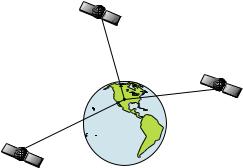
The unit automatically reads Custom Map Files directly from the MMC or SD card. To use a custom map, all you need to do is slide an MMC containing a map into the unit.
Introduction to GPS and WAAS
Well, now you know the basics of how the unit does its work. You might be ready to jump ahead to Section 2, Installation & Accessories, on page 11, so you can mount your unit and plug in the power. Or you might want to see how our text formatting makes the manual tutorials easy to skim. If that's the case, move on to "How to Use This Manual" on page 9. But, if you want to understand the current state of satellite navigation, look over this segment describing how GPS and its new companion WAAS work together to get you where you're going.
The Global Positioning System (GPS) was launched July 17, 1995 by the United States Department of Defense. It was designed as a 24- hour-a-day, 365-days-a-year, all weather global navigation system for the armed forces of the U.S. and its allies. Civilian use was also available at first, but it was less accurate because the military scrambled the signal somewhat, using a process called Selective Availability (SA.)
GPS proved so useful for civilian navigation that the federal government discontinued SA on May 2, 2000, after the military developed other methods to deny GPS service to enemy forces. Reliable accuracy for civilian users jumped from 100 meters (330 feet) under SA to the present level of 10 to 20 meters (about 30 to 60 feet.)
Twenty-four satellites orbit 10,900 nautical miles above the Earth, passing overhead twice daily. A series of ground stations (with precisely surveyed locations) controls the satellites and monitors their exact locations in the sky. Each satellite broadcasts a low-power signal that identifies the satellite and its position above the earth. Three of these satellites are spares, unused until needed. The rest virtually guarantee that at least four satellites are in view nearly anywhere on Earth at all times.
A minimum of three satellites are required to determine a 2D fix.
6
The system requires signal reception from three satellites in order to determine a position. This is called a 2D fix. It takes four satellites to determine both position and elevation (your height above sea level — also called altitude.) This is called a 3D fix.
Remember, the unit must have a clear view of the satellites in order to receive their signals. Unlike radio or television signals, GPS works at very high frequencies. These signals can be easily blocked by trees, buildings, an automobile roof, even your body.
Like most GPS receivers, this unit doesn’t have a compass or any other navigation aid built inside. It relies solely on the signals from the satellites to calculate a position. Speed, direction of travel, and distance are all calculated from position information. Therefore, in order for the unit to determine direction of travel, you must be moving and the faster, the better. This is not to say that it won’t work at walking or trolling speeds — it will. There will simply be more "wandering" of the data shown on the display.
GPS alone is plenty accurate for route navigation, but the U.S. Federal Aviation Administration has special aircraft navigation needs that go beyond basic GPS. So, the FAA has developed a program to boost GPS performance with its Wide Area Augmentation System, or WAAS. The FAA commissioned the system on July 11, 2003.
WAAS is designed to increase GPS accuracy to within 7.6 meters vertically and horizontally, but it consistently delivers accuracies within 1-2 meters horizontal and 2-3 meters vertical, according to the FAA. It does this by broadcasting correction signals on GPS frequencies. Your unit automatically receives both GPS and WAAS signals.
However, there are some fringe areas of the U.S., including parts of Alaska, that do not yet receive robust WAAS coverage. Continued WAAS development is planned to extend WAAS coverage in the years to come.
WAAS boosts the accuracy of land GPS navigation, but the system is designed for aircraft. The satellites are in a fixed orbit around the Equator, so they appear very low in the sky to someone on the ground in North America. Aircraft and vessels on open water can get consistently good WAAS reception, but terrain, foliage or even large man-made structures can sometimes block the WAAS signal from ground receivers.
You'll find that using your GPS receiver is both easy and amazingly accurate. It’s easily the most accurate method of electronic navigation available to the general public today. Remember, however, that this receiver is only a tool. Always have another method of navigation available, such as a map or chart and a compass.
7
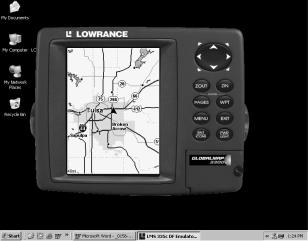
Also remember that this unit will always show navigation information in the shortest line from your present position to a waypoint, regardless of terrain! It only calculates position, it can’t know what’s between you and your destination, for example. It’s up to you to safely navigate around obstacles, no matter how you’re using this product.
Free Training Aids Available
Now that you know something about the technology that makes this unit possible, you're ready to start learning how to use that technology! This manual will guide you through the process of setting up and running your unit, but that's only one of many resources available.
If you or a friend has Internet access, visit our web site! Find us at WWW.LOWRANCE.COM. The site is packed with additional information on using our products.
Unit Emulator
For the ultimate training aid, be sure to download the free emulator software for your unit. Aside from being just plain fun, this program can help you learn both basic and advanced operations without burning boat fuel! Lowrance is the first GPS manufacturer to provide this type of training tool for customers.
This PC application simulates the actual GPS unit on your computer. You can run it from your computer keyboard or use your mouse to press the virtual keys. Easy download and installation instructions are available on our web site.
Free training emulator is available for your unit on our web site.
8
The emulator works exactly like your real GPS unit. Using the GPS Simulator feature, it allows you to run GPS routes and trails, even create real waypoints you can use in the field!
And that's just some of the material available on our web site. To find out all we have available, go to WWW.LOWRANCE.COM and look around. For now, though, we'll get back to how to use this particular unit. And, first, how to use the manual.
How to use this manual: typographical conventions
Many instructions are listed as numbered steps. The keypad and arrow "keystrokes" appear as boldface type. So, if you're in a real hurry (or just need a reminder), you can skim the instructions and pick out what menu command to use by finding the boldface command text. The following paragraphs explain how to interpret the text formatting for those commands and other instructions:
Arrow Keys
The arrow keys control the movement of dotted cross-hair lines on your mapping screen called the cursor. The arrow keys help you move around the menus so you can execute different commands. They are represented by symbols like these, which denote the down arrow key, the up arrow, the left arrow and the right arrow: ↓ ↑ ← →.
Keyboard
The other keys perform a variety of functions. When the text refers to a key to press, the key is shown in bold, sans serif type. For example, the "Enter/Icons" key is shown as ENT and the "Menu" key is shown as MENU.
Menu Commands
A menu command or a menu option will appear in small capital letters, in a bold sans serif type like this: ROUTE PLANNING. These indicate that you are to select this command or option from a menu or take an action of some kind with the menu item. Text that you may need to enter or file names you need to select are show in italic type, such as trail name.
Instructions = Menu Sequences
Most functions you perform with the unit are described as a sequence of key strokes and selecting menu commands. We've written them in a condensed manner for quick and easy reading.
For example, instructions for navigating a trail would look like this:
1. From the Map Page, press MENU|MENU|↓ to MY TRAILS|ENT.
9
2.Press ↓ to Trail 1|ENT|→ to NAVIGATE|ENT.
3.You are asked to wait while it converts the trail into a route.
4.The wait message disappears and the unit begins showing navigation information along the trail. Now, begin moving and follow your unit's directions.
Translated into complete English, step 1 above would mean: "Start on the Map Page. Press the Menu key twice. Next, repeatedly press (or press and hold) the down arrow key to scroll down the menu and select (highlight) the My Trails menu command. Finally, press the Enter key."
Step 2 would mean: "Press the down arrow key repeatedly to scroll to the trail named Trail 1, and press Enter. Next, press the right arrow key to highlight the Navigate command, then press Enter."
10
Section 2:
Installation & Accessories
Preparations
You can install the GPS system in some other order if you prefer, but we recommend this installation sequence:
Caution:
You should read over this entire installation section before drilling any holes in your vehicle or vessel!
1.Determine the approximate location for the GPS unit, so you can plan how and where to route the cables for the antenna and power. This will help you make sure you have enough cable length for the desired configuration.
2.Determine the approximate location for the GPS antenna module and its cable route.
3.Determine the location of your battery or other power connection, along with the power cable route.
4.Install the GPS antenna and route the antenna cable to the GPS unit's mounting location.
5.Install the power cable and route it to the GPS unit's mounting location.
6.Mount the GPS unit.
GPS Antenna/Receiver Module
This unit's package includes the LGC-2000 GPS module. This device contains the unit's external antenna and receiver for GPS and WAAS signals. The antenna/receiver module comes with a 25-foot Y-adapter extension cable. This module can be mounted on a flat surface or pole, or an optional magnet is available for temporary mounting on any ferrous surface.
The LGC-2000 requires 9 to 20 volts DC power. It draws power through the unit or from the NMEA 2000 buss (instructions on powering a NMEA 2000 buss appear later in this section).
11
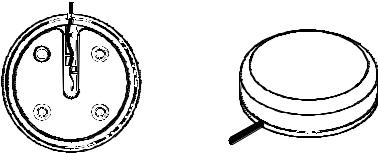
LGC-2000 Module, bottom view (left) and top view (right).
GPS Module Installation
The GPS module can be mounted on any flat surface, provided there is access behind the mounting surface for the screws. The optional magnet allows the module to be easily used on cars or off-road vehicles. The pole mount adapter lets you mount the antenna on a pole or swivel mount that uses standard marine 1" - 14 threads.
Surface Mount
Tools required for installation are: wire pliers, flat screwdriver, drill, 1" (25 mm) drill bit and 3/16" (4.75 mm) drill bit.
The GPS module can be easily installed on any flat surface that is at least 3-1/2" (90 mm) wide. Be sure that a clear, unobstructed view of the sky is available at the selected location. GPS signals travel "line-of- sight" at very high frequencies, so nearly anything blocking the antenna can stop the unit from finding a satellite. Caution: Do not mount in line with a radar antenna. Radar radiates high-energy signals that can interfere with GPS signal reception.
In an automobile, you may achieve good results by simply placing the external antenna on the top of the dash, at the base of the windshield. A piece of the rubber non-skid shelf liner material available in recreational vehicle supply stores will help hold the antenna in place. This may not work well if you have a cab-over design pickup truck camper or motor home. If dashboard reception is poor, simply relocate the antenna module elsewhere on the vehicle for a clearer view of the sky.
Once you’ve determined the mounting location, use the template on page 14 to drill the screw holes. The screws supplied with this unit are about 1-1/8" long (4mm x 30mm). Drill 3/16" (4.75 mm) holes for the mounting screws.
12
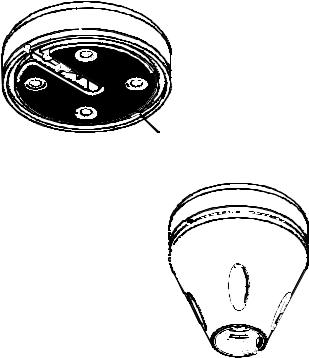
If you need to route the cable through the mounting surface, drill a 1" (25mm) hole for the cable's connector. There is a notch in the antenna housing that allows the cable to pass through to the outside, if desired, instead of routing it through the mounting surface.
After drilling the holes, pass the O-ring over the cable and press it into the groove on the bottom of the antenna housing. Now attach the antenna to the mounting surface, using 4 mm screws and the supplied lock washers. Route the cable (as described later in this section) and the GPS module installation is finished.
Magnet Mount
A magnet (available as an option) lets you temporarily mount the GPS module on any ferrous metal surface, such as a car. To use the magnet, simply peel the backing off the magnet's adhesive coating and press the magnet to the bottom of the antenna housing. The module is ready for use.
Magnet
Under side view showing magnet.
Pole Mount
The GPS module attaches to the pole mount adapter with the supplied 4 mm screws. You can route the cable through the slot in the side of the module and down the side of the pole. Or, you can pass it down through the pole mount adapter and run the cable inside the pole. The 1"-14 threads on the pole mount adapter accept a standard marine antenna mount.
Pole mount adapter with module attached.
13
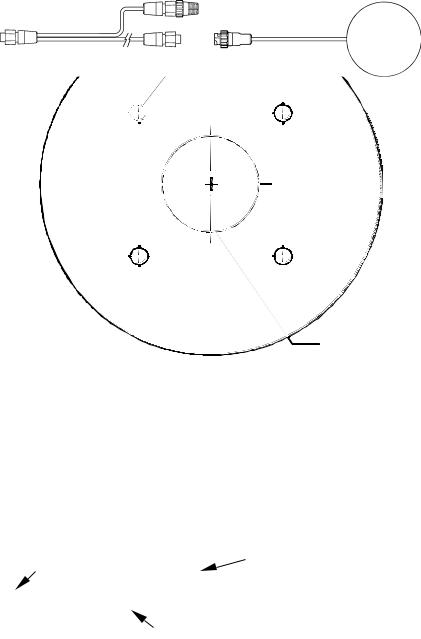
Drill size 3/16" (4.75 mm)
Drill four places.
Drill size 1" (25 mm ) (If needed.)
GPS module mounting template.
After the module is installed, connect it to the unit. The LGC-2000 can communicate with your GPS unit either directly (using the supplied extension cable) or through a NMEA 2000 network.
Connecting Directly to the Unit
After the module is installed, attach it to the end of the Y-adapter extension cable as shown in the following diagram. To connect it to the unit, insert the extension cable's splitter plug into the Network socket on the back of the unit and your system is ready to use.
|
Splitter plug |
60-ohm |
|
terminator |
|
|
|
|
|
|
LGC-2000 |
To unit |
|
25' Y-adapter |
|
|
extension cable |
LGC-2000 direct connection to GPS unit.
14
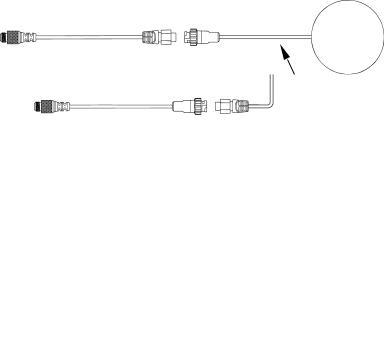
NOTE:
The extension cable’s shorter branch will have a 60-ohm terminator attached to it. Do not remove this terminator. When you're not connecting to a NMEA 2000 buss, you must leave the terminator connected to this socket for your antenna/receiver to function correctly.
Connecting to a NMEA 2000 Network
The LGC-2000 can be connected to a NMEA 2000 buss, providing GPS information to any Lowrance GPS units attached to the buss. Contact LEI Extras (look inside back cover for accessory ordering information) for a NMEA 2000 buss adapter cable if you would like to do this.
There are two ways to connect the antenna to a NMEA 2000 network port. One method (shown in the following image) is to use the extension cable's Y-adapter to connect both the antenna and the unit to the same network port. To do this, simply remove the 60-ohm terminator shown in the previous image and attach the NMEA 2000 buss adapter cable to the shorter branch of the extension cable's Y-adapter. Connect the NMEA 2000 buss adapter cable's other end to an available network port.
To unit
LGC-2000
25' Y-adapter extension cable
To NMEA 2000 network port
LGC-2000 and GPS unit connection to NMEA 2000 buss.
You can also attach the antenna to a remote port on the network, and pass position information along the network. To do this, simply attach the LGC-2000's connector to one end of the buss adapter cable and attach the other to an available port on the NMEA 2000 buss, as shown in the following image. (You will have to use a similar adapter cable to connect the GPS unit to the NMEA buss as described later in this section.)
To NMEA 2000 network port
LGC-2000
LGC-2000 remote connection to NMEA 2000 buss.
15
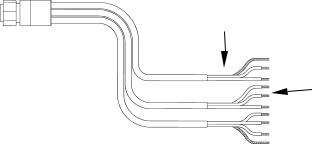
NOTE:
An existing operational NMEA 2000 buss will already have terminators in place and will already be powered. If you're connecting to such a network, you won't need the terminators provided. Do not add terminators or power to a functional NMEA 2000 buss!
When the LGC-2000 is connected to the unit (directly or indirectly), it will begin providing GPS signal information.
Power Connections
Your unit comes with a Lowrance standard power/data cable that splits into three ends, each with several exposed wires (shown in the following figure). The end with 4 wires (blue, yellow, orange and shield) is a Data cable that connects to a NMEA 0183 interface. The end with three wires (red, black and shield) is a power cable that connects to a NMEA 2000 buss. The thicker three-wire cable (red, black and white) is the Power Supply for your unit (and optional external speaker connection for some units).
Power Supply wires: red, black and white
To unit
NMEA 2000 Power wires:
red, black and shield
NMEA 0183 Data Cable wires: blue, yellow, orange and shield
The Power/Data cable for this unit.
Depending on your configuration, you may not use all of these wires. (For example, many units cannot operate an optional external speaker, so the white wire on the Power Supply cable isn't functional.) The following segments include instructions for installing all the wires that you will use with this unit.
Caution:
All of the wires in the power/data cable have bare ends for easier installation. The bare ends on any unused wires could cause an electrical short if left exposed. To prevent this, you should cover the individual wire ends – either by capping them with wire nuts or wrapping them with electrical tape. (You should cut off the bare wire before taping off the ends.)
16
Powering a NMEA 2000 Buss (NMEA 2000 Power cable)
A NMEA 2000 buss must be connected to a power source to operate. If you have a pre-existing NMEA 2000 installation, it may already be connected to another power source. If your NMEA 2000 buss is already powered, you can ignore the NMEA 2000 Power cable. Never attach two power sources to a single NMEA 2000 buss.
If you do need to power your NMEA 2000 buss, attach the NMEA 2000 Power cable to your boat's battery just as indicated in the following segment for connecting your unit's Power Supply cable. The NMEA 2000 Power cable's red wire should be attached (with provided 3-amp fuse) to the boat battery's positive terminal, and the NMEA 2000 Power cable's black and shield wires should both be attached to the battery's negative terminal.
NOTE:
If the NMEA 2000 buss draws power directly from the boat's battery, the LGC-2000 will remain on (drawing power) all the time. The LGC2000's current draw is very small and shouldn't decrease the boat's storage battery life, but if this small draw is a concern, you can install a switch between the NMEA 2000 buss and the battery.
Powering Your Unit
(Power Supply cable – red and black wires)
The unit works from a 12-volt battery system. For the best results, attach the power cable directly to the battery. You can attach the power cable to an accessory or power buss, however you may have problems with electrical interference. Therefore, it's safer to go ahead and attach the power cable directly to the battery.
CAUTION:
When using the unit in a saltwater environment, we strongly recommend that you shut off the power supply to the power cable when the unit is not in use. When the unit is turned off but still connected to a power supply, electrolysis can occur in the power cable plug. This may result in corrosion of the plug body along with the electrical contacts in the cable and the unit's power socket.
In saltwater environments we recommend you connect the power cable to the auxiliary power switch included in most boat designs. If that results in electrical interference, or if such a switch is not available, we recommend connecting direct to the battery and installing an inline switch. This will let you shut off power to the
17
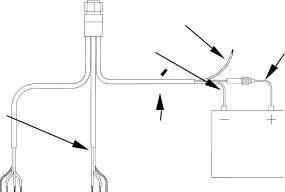
power cable when the unit is not in use. When you are not using the unit, you should always shut off power to the power cable, especially when the power cable is disconnected from the unit.
If possible, keep the power cable away from other boat wiring, especially the engine's wires. This will provide the best isolation from electrical noise. If the cable is not long enough, splice #18 gauge wire onto it. The power cable has two wires, red and black. Red is the positive lead, black is negative or ground. There is also a white wire to power an optional external speaker for some units. Make sure to attach the in-line fuse holder to the red lead as close to the power source as possible.
For example, if you have to extend the power cable to the battery or power buss, attach one end of the fuse holder directly to the battery or power buss. This will protect both the unit and the power cable in the event of a short. It uses a 3-amp fuse.
To power a NMEA 2000 buss, also connect NMEA 2000 Power cable to the boat's battery.
|
White external speaker wire |
||
To unit |
(not used by this unit) |
||
|
|
|
|
|
Black wire |
||
|
|
|
|
|
|
|
|
Optional power off |
|
switch for salt- |
12 volt |
water installations |
battery |
Red wire with 3 amp fuse
Data Cable NMEA 2000 Power Cable
Power connections for the unit.
NOTE:
If you're powering a NMEA 2000 buss, you will attach both the NMEA 2000 Power cable and the unit's Power Supply cable to the boat's battery. To attach the NMEA 2000 Power cable, connect the red wire to battery's + and black and shield wires to battery's –.
WARNING:
This product must be independently fused with the enclosed 3-amp fuse (or equivalent), even if you connect to a fused accessory or power buss.
18

If a malfunction happens inside the unit, extensive damage can occur if the enclosed fuse is not used. As with all electrical devices, this unit could be damaged to a point that it is unrepairable and could even cause harm to the user when not properly fused.
CAUTION:
Do not use this product without a 3-amp fuse wired into the power cable! Failure to use a 3-amp fuse will void your warranty.
This unit has reverse polarity protection. No damage will occur if the power wires are reversed. However, the unit will not work until the wires are attached correctly.
An optional 8-foot, CA-4 external power cable with a cigarette lighter adapter is available from Lowrance.
NMEA 2000 Cable Connections
NMEA 2000 is a new buss network specifically designed for boats. This is a very young industry standard and, at the time of printing, few boats being built now have a NMEA 2000 buss installed. Over the next few years, however, NMEA 2000 will become much more common. To help you get the most out of this technology, your Lowrance unit is designed to work with a NMEA 2000 network as soon as it becomes available.
Connecting to a NMEA 2000 Network
Your unit can be connected to a NMEA 2000 buss, receiving sensor information from any Lowrance units attached to the buss. Contact LEI Extras (look inside back cover for accessory ordering information) for a NMEA 2000 buss adapter cable if you would like to do this. You can connect both the unit and antenna module through the antenna's extension cable (as described earlier), or you can connect the unit directly to a network port. To do so, simply attach the adapter cable's manual locking collar connector to the Network port on the back of the unit and attach the other end to an available port on the NMEA 2000 buss, as shown in the following image.
To NMEA 2000 |
To GlobalMap's |
network port |
Network socket |
Lowrance unit direct connection to NMEA 2000 buss.
As soon as the unit is connected to the network, it will begin receiving shared information. Please note that the buss must be powered to operate. (For more on powering a NMEA 2000 buss, see the instructions earlier in this section.)
19
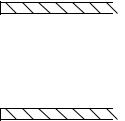
NMEA 0183 Cable Connections
NMEA is a standard communications format for marine electronic equipment. For example, an autopilot can connect to the NMEA interface on this unit and receive positioning information. The unit can exchange information with any device that transmits or receives NMEA 0183 data.
See the following diagram for general wiring connections. Read your other product’s owner’s manual for more wiring information.
NMEA 0183 Wiring (Data cable)
To exchange NMEA 0183 data, this unit has one NMEA 0183 version 2.0 communication port. Com port one (Com-1) can be used to receive NMEA format GPS data. The com port can also transmit NMEA format GPS data to another device.
The four wires for the com port are combined with the Power Supply cable and NMEA 2000 Power cable to form the power/data cable (shown earlier). Com-1 uses the yellow wire to transmit, the orange wire to receive and the shield wire for signal ground. Your unit does not use the blue wire.
|
|
Orange (Receive) |
|
NMEA Transmit |
To Other |
|
Com-1 |
|
|
|
|
|
|
|
Shield (Ground) |
|
Ground |
GPS Receiver |
||
To unit |
|
|
||||
|
|
|
|
|
|
|
|
|
|
|
|
|
|
|
Com-1 wiring to receive NMEA position information |
|||||
|
|
from some other GPS receiver. |
|
|||
|
|
Yellow (Transmit) |
|
NMEA Receive |
|
|
Com-1 |
|
|
|
|
|
To Other |
|
|
|
|
|
||
|
Shield (Ground) |
|
Ground |
|||
To unit |
|
|
Device |
|||
|
|
|
|
|
|
|
Com-1 wiring to transmit NMEA position information to another NMEA-compatible device.
20
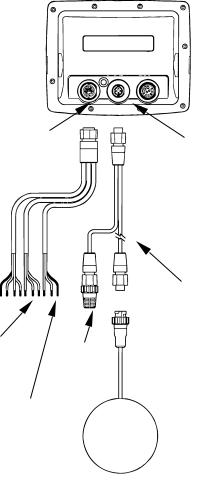
GPS unit, rear view
Power/Data socket |
Network socket |
NMEA 0183 Data cable (four wires)
LGC-2000 25' extension cable
NMEA 2000 |
60-ohm |
|
Power cable |
||
terminator |
||
|
Power Supply
cable GPS antenna module
Cable connections shown.
Mounting the Unit: Bracket or In-Dash Installation
You can install the unit on the top of a dash with the supplied gimbal bracket. It can also be installed in the dash or mounted on a portable power supply.
If you use the supplied bracket, you may be interested in the optional R-A-M bracket mounting system. This converts the unit's gimbal bracket to a swivel mount, which can be used on the dash or overhead mounting positions.
21

Optional R-A-M mounting system.
Bracket Installation
Mount the unit in any convenient location, provided there is clearance behind the unit when it's tilted for the best viewing angle. You should also make sure there is enough room behind the unit to attach the power, transducer and GPS antenna/receiver module cables. (A drawing on the next page shows the dimensions of a gimbal-mounted unit.)
Holes in the bracket's base allow wood screw or through-bolt mounting. You may need to place a piece of plywood on the back side of thin fiberglass panels to reinforce the panel and secure the mounting hardware.
Front
Install the gimbal bracket. Orient the bracket so the arms slope toward the front of your unit.
22
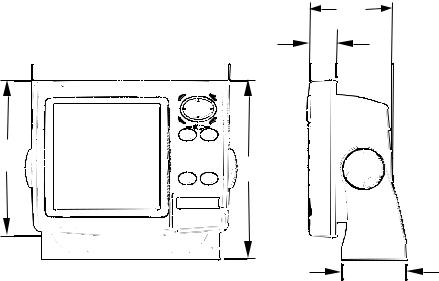
Drill a 1-inch (25.4 mm) hole in the dash for the power, transducer and antenna cables. The best location for this hole is immediately under the gimbal bracket location. This way, the bracket can be installed so that it covers the hole, holds the cables in position and results in a neat installation. Some customers, however, prefer to mount the bracket to the side of the cable hole — it's a matter of personal preference.
77.1
[3.03]
27.6
173.9 [1.09]  [6.85]
[6.85] 
137.9 
 [5.43]
[5.43] 
 157.9
157.9
[6.22]
Millimeter |
56.9 |
|
[2.24] |
||
[Inch] |
||
|
Front view (left) and side view (right) showing dimensions of GlobalMap 3300C GPS unit when mounted on gimbal bracket.
After drilling the hole, pass the transducer connector up through the hole from under the dash, followed by antenna connector. Pass the power cable's bare-wire end down though the hole from the top.
If you wish, you can fill in the hole around the cables with a good marine caulking compound. (Some marine dealers stock cable hole covers to conceal the opening.) No matter what type of installation you prefer, be sure to leave enough slack in the cables to allow tilting or swiveling the unit. If you choose to fill in the hole, be sure to position the cables against the rear edge of the hole as you apply the fill material.
Before positioning the bracket, be sure to hold the cables against the rear edge of the hole. Then, slide the bracket over the hole and butt the rear of the bracket base firmly against the cables, thus pinning them in
23
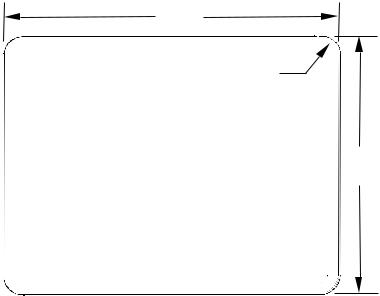
place against the side of the hole. Finally, fasten the bracket to the dash. Attach the unit to the gimbal bracket using the supplied gimbal knobs and washers.
In-Dash Installation
You can mount the unit in the dash with an optional FM-5 In-Dash Adapter Kit. The kit includes mounting hardware, a template for cutting the hole and an instruction sheet, part 988-0147-43.
146.5
[5.76]
Top
R 7.9 [0.31]
In-Dash
113.5
Template [4.46]
Millimeters
[Inches]
ALWAYS VERIFY DIMENSIONS
In-dash mounting template for GlobalMap 3300C GPS unit, showing dimensions. NOTE: The figure above is not printed to scale. A scaled template (FM-5 In-Dash Adapter Kit instructions) is available for free download from our web site, www.lowrance.com.
MMC or SD Card Memory Card Installation
Your unit uses a MultiMedia Card to store information, such as custom maps, waypoints, trails and other GPS data. The unit can also use Secure Digital Cards (SD card) to store data.
NOTE:
Throughout this manual, we will use the term MMC, but just remember that your unit can use an MMC or SD card to store data.
Both of these solid-state flash memory devices are about the size of a postage stamp. An SD card is slightly thicker than an MMC. As this manual went to press, MMCs were available in storage capacities of 8 MB, 16 MB, 32 MB, 64 MB and 128 MB. SD cards were available in capacities of 8 MB, 16 MB, 32 MB, 64 MB, 128 MB, 256 MB and higher.
24
